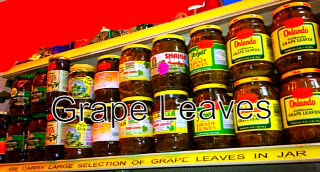Grape leaves are used in the cuisines of a number of cultures, including Turkish Cuisine, Greek Cuisine, Bulgarian Cuisine, Arab Cuisine, Romanian Cuisine, and Vietnamese Cuisine and Persian Cuisine, They are most often picked fresh from the vine and stuffed with a mixture of Rice, Meat, and Spices, and then cooked by boiling or steaming. Stuffed grape leaves can be served as an Appetizer or as a main dish. It is available at Pars Market we sell wide selection of Grape Leaves in Jar or Vacuum pack all at very reasonable prices!
Fiber
Use grape leaves to boost your intake of roughage. The leaves provide a rich source of fiber, 1.5 grams per cup. This means that, despite containing very few calories, grape leaves will help fill you up. Grape leaves' fiber content adds bulk to your food to help physically fill your stomach, and also helps slow digestion so that you get a gradual release of sugar into your bloodstream, instead of a blood sugar spike and crash that leaves you ravenous. A 1-cup serving of leaves provides about 7 percent of your fiber intake if you follow a 1,500-calorie diet, according to the Harvard School of Public Health, or 5 percent if you're on a 2,000-calorie diet.
PARS MARKET LLC
9400 SNOWDEN RIVER PARKWAY # 109
COLUMBIA, MD, 21045
443-259-0002
http://www.parsmarketcolumbia.com
http://parsmarketcolumbia.blogspot.com
 |
| Our Large Selection of Grape Leaves |
Fiber
Use grape leaves to boost your intake of roughage. The leaves provide a rich source of fiber, 1.5 grams per cup. This means that, despite containing very few calories, grape leaves will help fill you up. Grape leaves' fiber content adds bulk to your food to help physically fill your stomach, and also helps slow digestion so that you get a gradual release of sugar into your bloodstream, instead of a blood sugar spike and crash that leaves you ravenous. A 1-cup serving of leaves provides about 7 percent of your fiber intake if you follow a 1,500-calorie diet, according to the Harvard School of Public Health, or 5 percent if you're on a 2,000-calorie diet.
Vitamins A and K
Grape leaves boost your intake of vitamins, and provide a particularly rich source of the fat-soluble vitamins A and K. Vitamin A helps your cells develop, guiding their development from non-functional immature cells into specialized cells that become a part of functional tissue. Your bones, skin, digestive tract and visual system all rely on vitamin A to function. Vitamin K helps control blood clotting. Healthy levels of the vitamin allow you to form blood clots after an injury, so that the clot can prevent blood flow out of the wound and limit your blood loss. A 1-cup serving of grape leaves contains 3,853 international units of vitamin A, your entire day's recommended intake of the nutrient, according to the Linus Pauling Institute. A cup of grape leaves also contains 15.2 micrograms of vitamin K, 17 percent of the recommended intake for women or 13 percent for men, according to the LPI.Calcium and Iron
Grape leaves also provide you with calcium and iron, two essential minerals. Your body needs calcium to keep your bones and teeth strong, and also relies on the mineral for nerve and muscle function. Each cup of grape leaves contains 51 milligrams of calcium, about 5 percent of the calcium you need each day, according to the Linus Pauling Institute. The iron in grape leaves promotes healthy circulation -- the mineral helps your blood carry oxygen throughout your body. A 1-cup serving of the leaves provides 0.37 milligrams of iron -- 4 percent of the daily iron requirements for men, according to the Linus Pauling Institute, or 2 percent for women.Cooking with Grape Leaves
Stuff your grape leaves with healthy ingredients to make nutrient-dense meals. Try stuffing grape leaves with chicken and chopped vegetables, then bake until tender for a meal rich in protein, fiber, vitamins and minerals. For a vegetarian option, substitute tofu or tempeh for meat as a source of protein, and add mushrooms for a meaty texture. Steam leftover grape leaves for use in pureed soup -- a blend of broccoli, onions, kale, grape leaves and other green veggies makes for a flavorful and nutrient-packed meal. |
| A Jar of Grape Leaves at Pars Market |
PARS MARKET LLC
9400 SNOWDEN RIVER PARKWAY # 109
COLUMBIA, MD, 21045
443-259-0002
http://www.parsmarketcolumbia.com
http://parsmarketcolumbia.blogspot.com
Comments
Post a Comment
your comments here!